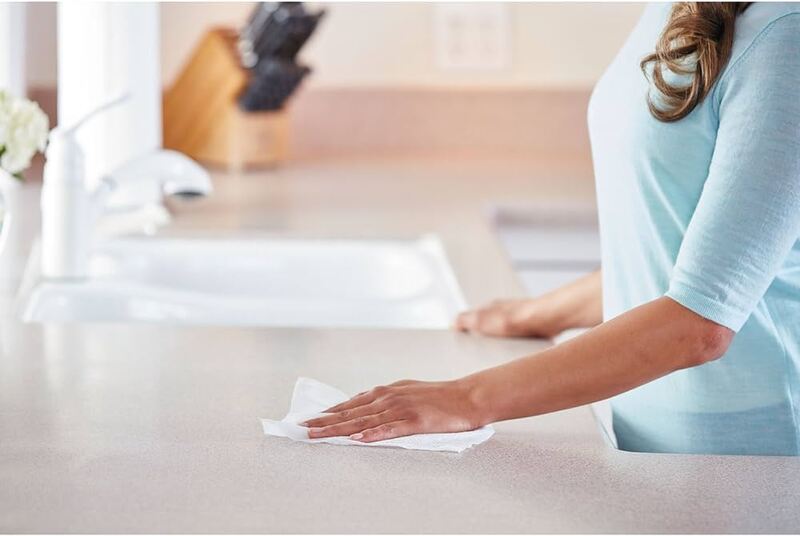Antibacterial wipes are increasingly popular, especially after the Covid-19 pandemic. Therefore, how to use antibacterial wipes correctly is important to maximize their effectiveness and ensure health safety when using them. Learn more about this issue with DHTI in the article below.
Read more: Private label wipes manufacturer – “Make your own wet wipes” solution
Before you learn how to use antibacterial wipes, it is important to understand how they work. Antibacterial wipes kill or inhibit the growth of bacteria, viruses, and other microorganisms by using a combination of disinfectant chemicals. The exact mechanism of action can vary depending on the specific ingredients in the wipes, but here is a general overview of how they work:
1 – Active Ingredients: Antibacterial wipes are composed of active ingredients that are designed to kill or inhibit the growth of microorganisms. Common active ingredients include quaternary ammonium compounds (quats), alcohol (usually isopropyl or ethanol), hydrogen peroxide, or other disinfectants.
2 – Surface Contact: When you use an antibacterial wipe, you apply the disinfectant directly to the surface. The wipe provides a convenient and controlled way to distribute the disinfectant evenly.
3 – Mechanical Action: Wiping a surface helps remove dirt, debris and microorganisms by physically removing them from the surface. This action can be important when dealing with visibly dirty or soiled surfaces.
4 – Chemical Action: The active ingredients in the wipe work on the surface microorganisms. The mechanism of action depends on the active ingredient. For example:
5 – Contact Time: Antibacterial wipes need a specific contact time to effectively kill or inhibit the growth of microorganisms. This is the duration the surface must remain wet with the disinfectant. Contact times can vary depending on the product and its active ingredients, but they are typically in the range of 30 seconds to a few minutes.
6 – Rinse-Free: Antibacterial wipes are often rinse-free, meaning you don’t need to rinse the surface after using the wipe. However, it is important to allow the surface to air dry so that the disinfectant can do its job and kill off harmful bacteria.
7 – Residue: Some antibacterial wipes can leave behind a residue after use. This residue is important because it provides some residual disinfection, continuing to work against microorganisms even after the surface has dried. The residue may also attract dirt and dust, so it’s essential to follow up with regular cleaning as needed.
8 – Effectiveness: The effectiveness of antibacterial wipes depends on a number of factors including the type of microorganisms they target, the concentration of active ingredient, and how well you follow the manufacturer’s instructions.
To use antibacterial wipes effectively, you need to follow the product label’s instructions from a wet wipes manufacturer. They are useful for disinfection but should not be used as a sole method of maintaining a clean environment. Regular cleaning with soap and water is still essential for removing dirt and grime from surfaces.

Antibacterial wipes need a specific contact time to effectively kill the growth of microorganisms
Learn more: Alcohol Wet Wipes Manufacturer: High-Quality, Trusted Products
Antibacterial wipes are a convenient way to clean and disinfect surfaces, helping to reduce the spread of germs and prevent illness. Here are some useful tips on how to use antibacterial wipes:
1 – Read the Label: Always read the labels on antibacterial wipes to understand the specific instructions and recommendations for those products. Different brands may have slightly different guidelines.
2 – Wash Hands First: Before using antibacterial wipes, wash your hands thoroughly with soap and water. Wiping your hands on an infected surface can spread germs further, so it’s important to avoid doing so.
3 – Choose the Right Wipe: Wipes come in a variety of designs, so it’s important to find one that is appropriate for the surface you’re cleaning. Some wipes are designed specifically for electronics, while others can be used on most household surfaces.
4 – Pre-Cleaning: It’s a good idea to do some light pre-cleaning with a damp cloth or paper towel before using the antibacterial wipe if you notice that your kitchen countertop is visibly dirty, has crumbs and debris. This will help ensure that the disinfectant in the wipe works more effectively
5 – Use One Wipe Per Surface: Reusing wipes can spread germs, so use one wipe for each surface you clean.
6 – Follow Contact Time: Antibacterial wipes are effective only if you let them remain in contact with the surface for at least a certain amount of time. This is usually printed on the packaging, so make sure to follow instructions and keep surfaces wet with disinfectant until they dry.
7 – Avoid Over-wetting: While you want the surface to remain wet for the specified contact time, avoid oversaturating it with the wipe, as this can damage some materials. Use just enough to keep the surface moist.
8 – Allow to Air Dry: When wiping, avoid over-saturating the surface with wipe solution. This may damage certain materials. Use just enough to keep the surface moist.
9 – Dispose of Wipes Properly: Wipes should be thrown away in the trash, not flushed down the toilet.
10 – Wash Hands After Use: When wiping, avoid over-saturating the surface with a wipe solution. This may damage certain materials. Use just enough to keep the surface moist.
11 – Store Properly: Store wipes in their original packaging or a resealable container to prevent drying and keep them away from children. Store the containers in a cool, dry place away from sunlight.
12 – Use with Caution on Electronics: If you’re using antibacterial wipes to clean your smartphone or laptop, make sure not to damage the sensitive screens or components. Use a gentle touch and keep the wipe from getting too wet.
13 – Don’t Use on Food Contact Surfaces: Antibacterial wipes should not be used to clean cutting boards or kitchen surfaces that come into contact with food, like dishes and chopping blocks. Instead they can be wasted on less important, non-food related objects such as the bathroom sink faucet handle—which you probably won’t eat off of anyway!
14 – Check Expiry Date: Do not use wipes after their expiration date.

You should wash your hands before and after using antibacterial wipes
Antibacterial wipes can be useful for cleaning but should not be the only method used to maintain a clean and healthy environment. Proper cleaning with soap and water is also important, especially for removing dirt and grime from surfaces.
Related: How to Use Wet Wipes: A Comprehensive Guide for Beginners
To use antibacterial wipes properly and effectively, you need to buy quality products. You should buy this type of towel from a reputable company with complete paperwork.
DHTI is an antibacterial wet wipes manufacturer and supplier with over 23 years of experience. Our products guarantee safety and quality, with carefully selected ingredients, according to FDA recommendations. We have modernized our wet wipes production line to meet ISO 9001:2015 standards.
Furthermore, we also offer on-demand production services including OEM wet wipes/ODM wet wipes. Contact us for more detailed information.

DHTI have modernized our production line to meet ISO 9001:2015 standards
In conclusion, antibacterial wipes are convenient and efffective for a quick clean in contaminated areas like kitchens, hospitals,… But, you have to learn how to use antibacterial wipes correctly. You should also remember to buy products from reputable distributors in order to ensure quality. If you have any questions, please contact us for advice.
Dong Hiep Trading and Investment Joint Stock Company:
Discover more useful information about antibacterial wipes: